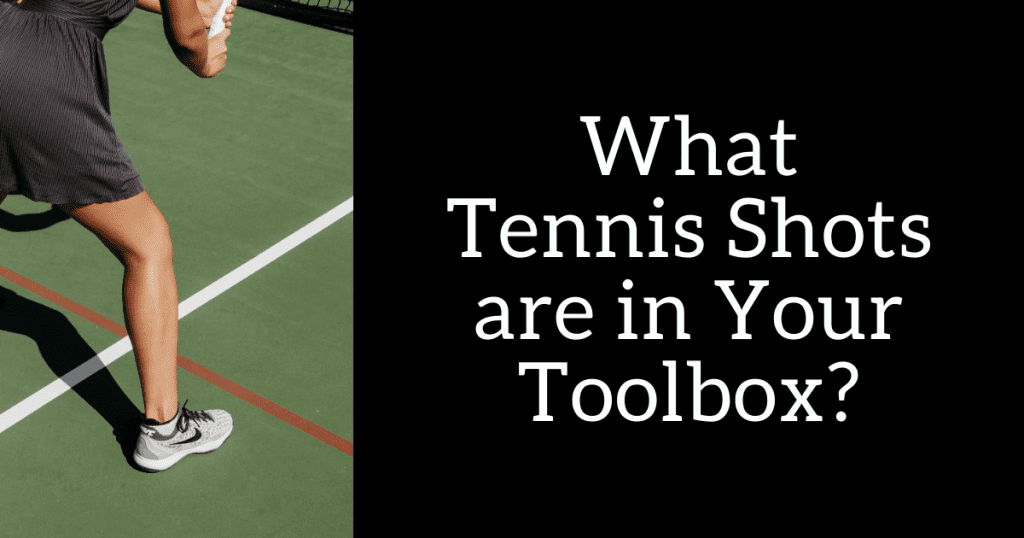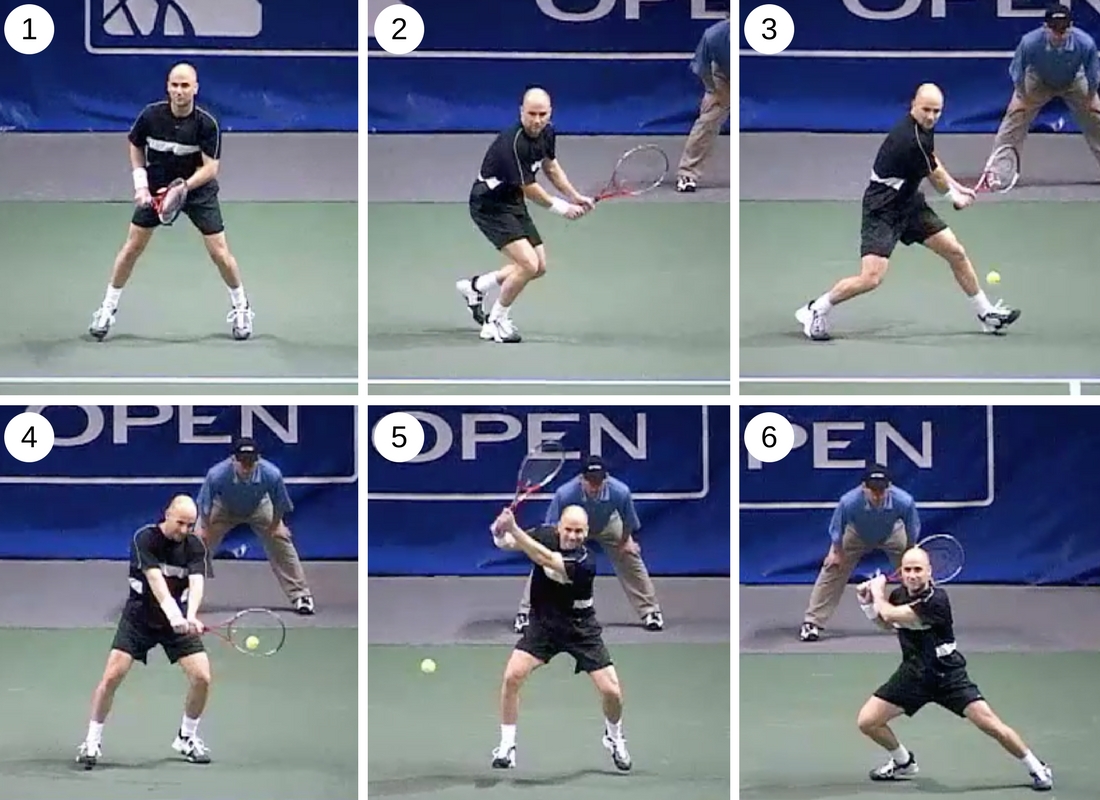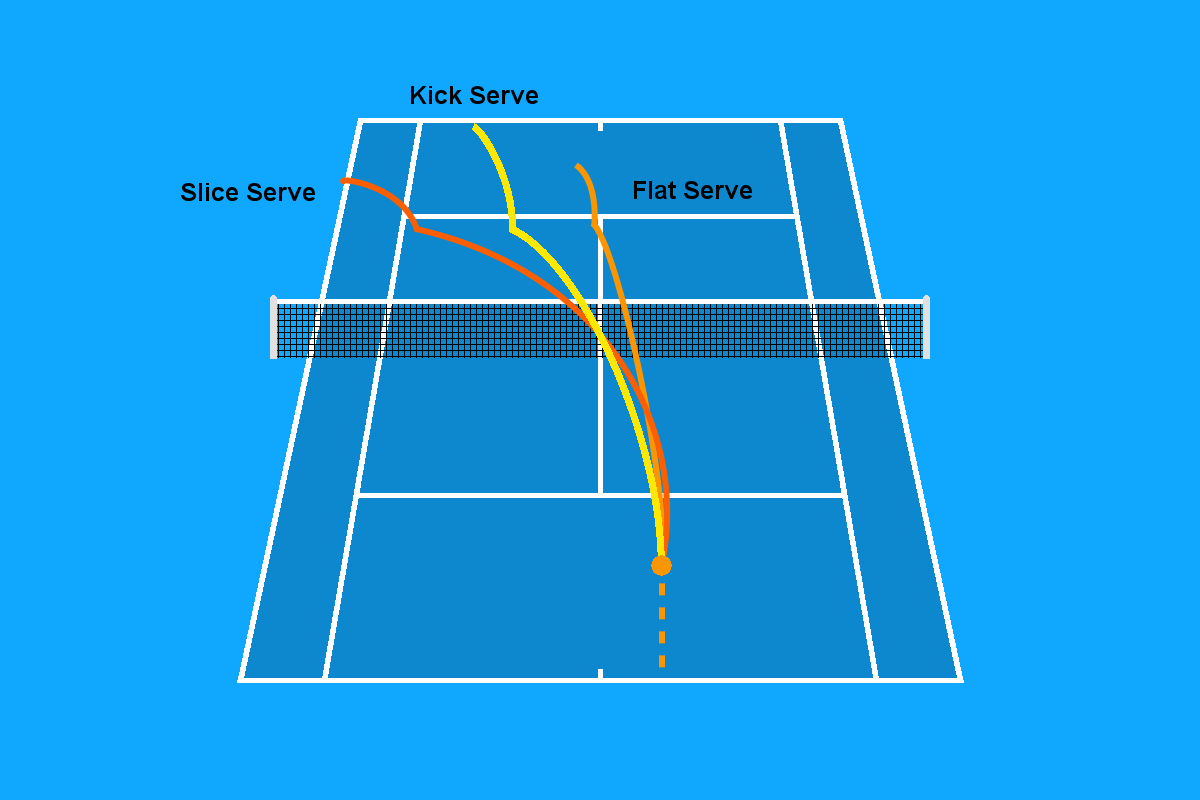When you first start playing tennis, you must learn the different types of strokes and how to execute them properly. This will give you a strong foundation to build your game. As you become more experienced, you can practice more advanced strokes and improve your game. In this article we will discuss what tennis shots are in your toolbox.

Here are some of the most common strokes you’ll need in your toolbox:
Exploring Different Types of Tennis Shots
There are a variety of different tennis shots that can be used to win a point. Each shot has its unique purpose and can be executed in several different ways. The following is a list of some of the most common types of tennis shots:
You can buy Wilson Tennis Racquet if you want to learn basic tennis shots as a beginer.
The serve is perhaps the most crucial shot in tennis. A good serve can be the difference between winning and losing a match. There are several different ways to hit a serve, but all should be aimed at getting the ball into the opponent’s service box.

Groundstrokes
Tennis is a game that’s all about groundstrokes. Forehands, backhands, and slices are all important strokes you need to master to be a good tennis player. Forehands and backhands are the two main types of groundstrokes in tennis.
A slice is a variation of these strokes used to keep the ball low and challenge your opponent to attack. To hit these strokes effectively, you should start with your racket hand behind the ball and swing it up and across your body, making contact with it before reaching its highest point. This will give you power and control over the shot. Practice these strokes often and master them to improve your tennis game.
In this section, we’ll look at each of these strokes and provide tips on improving your game.
Tennis Groundstroke: Forehand
The most vital stroke in tennis is the forehand groundstroke. Players who consistently hit forehand groundstrokes with power and accuracy are typically the best in the game.
Two main ways to hit a forehand groundstroke are with a Western or an Eastern grip. The Western grip is the more traditional grip for a forehand and is the grip most players use. The Eastern grip is less common, but some of the best players in the world (such as Rafael Nadal and Novak Djokovic) use it significantly.
The main difference between the two grips is that the Western grip puts more emphasis on topspin, while the Eastern grip emphasises flat, hard strokes.
The forehand is the stroke that most people think of when they think of tennis. It’s a powerful shot that can be used to win points quickly. When hitting a forehand, you should start with your racket hand behind the ball and swing it up and across your body, making contact with it before reaching its highest point. This will give you the most power and control over the shot.
Tennis Groundstroke: Backhand
The backhand is the other primary stroke in tennis. It’s not quite as powerful as the forehand, but it can be just as effective if executed properly. When hitting a backhand, you should start with your racket hand in front of the ball and swing it down and across your body, making contact with the ball just above your hip. This stroke is often used to return balls hit to your backhand side or keep your opponent from taking control of the point.
There are two main types of backhand strokes: the one-handed backhand and the two-handed backhand. The one-handed backhand is generally considered more challenging to execute but provides more power and control. The two-handed backhand is a little easier to learn and can be just as effective if played correctly.
The backhand is a stroke often used when your opponent is on the other side of the court, and you can’t reach the ball with a forehand. It can also be used as an approach or a defensive shot when trying to stay at the point. To hit a backhand, start with your racket hand in front of the ball and swing it up and across your body, making contact with it before reaching its highest point.
Slice Forehands and Backhands
A slice is a type of groundstroke with a lot of spins. This can keep the ball low and make it difficult for your opponent to attack. To hit a slice, start with your racket hand behind the ball and swing it up and across your body, making contact with the ball just before it reaches its highest point. This will give you a spin and keep the ball low.
Volleys and Half Volleys
Volleys and half volleys are shots that are hit before the ball bounces. Volleys are hit with the player’s feet off the ground, while half volleys are hit with the player’s feet.
Volleys are usually hit when the player is close to the net and are often used to surprise the opponent. Half-volleys are typically hit when the player is further away from the net and are often used to keep the ball in play.
Volleys and half volleys can be very effective shots, but they can also be tough to control. Players who hit these shots must be very accurate and have good timing.
Volleys and half volleys are two of the most important shots in tennis, and they are both used to win points. Volleys are hit before the ball bounces, while half volleys are hit after the ball bounces. Both of these shots can be very effective but can also be very difficult to control. Players who hit these shots must be very accurate and have good timing.
High Tennis Shots Crossword Clue
High shots may frequently be game-changers in tennis, but understanding the crossword puzzle for such shots can be just as exciting. High tennis shots may be lobs or moonballs, which are intentional strokes designed to lift the ball high over the net and create an advantageous position. These shots, which require precision and timing, bring a fascinating dimension to the game. So, the next time you see this crossword puzzle, you’ll know what’s up with those soaring tennis strokes!
Soft Shots In Tennis Crossword Clue
When it comes to tennis, not every stroke is a sure victory. The game’s problem often extends to crossword clues, such as soft shots in tennis. To solve this puzzle, you must be familiar with the delicate art of drop shots and dinks.
A drop shot is a tactical stroke in which the ball is barely touched over the net, frequently surprising opponents. It demands accuracy and skill, making it an essential tool for players. Dinks are delicate volleys done with a mild touch that is generally employed during net play. So, recall the delicate and strategic soft strokes that lend refinement and interest to the game of tennis the next time you come across this crossword puzzle.
Serves
The service is the most important shot in tennis, and it is the only one the player has complete control over. The player can choose where, how hard to serve, and what type of spin to put on the ball.
Players usually try to serve the ball into the opponent’s backhand because it is harder to return a backhand shot. Players can also try to surprise the opponent by serving to the forehand or using a slice.
Players must be very careful when they serve because they will lose the point if they miss their service. Players must also be careful not to double-fault because that would mean losing the end.

Flat Serve
The flat serve is the most common type and is hit with little or no spin. The player hits the ball in the middle of the strings, and the ball goes straight forward. This type of service is very accurate and difficult to return.
Kick Serve
The kick serve is a type of service that is hit with many spins. The player hits the ball above the centre of the strings, and the ball goes up into the air and down into the court. This service is very effective because it is difficult to return.
Slice Serve
The slice serves a type of service that is hit with a sidespin. The player hits the ball below the centre of the strings, and the ball goes across the court. This type of service is very effective because it is difficult to return.
Specialty Tennis Shot Situations
Lob
The Lob is a shot that is delivered from the backcourt. This shot can be hit with either a lob pass or an overhead smash. The Lob is one of the most challenging shots to make in tennis because it requires a great deal of power and accuracy. If you want to improve your Lob, practice hitting this shot repeatedly until it becomes second nature for you and then incorporate it into your game.
Overhead Smash
The overhead smash is a powerful shot that requires great hand speed and power and excellent court coverage by your opponent. This shot also requires some finesse so that you don’t get caught off guard by an opponent who moves in front of the ball at just the wrong moment!
To execute this shot effectively, you’ll need to have solid forehands and backhand strokes and good court coverage skills to cover ground quickly enough to give yourself time on your side of the net before returning serve to give yourself room for error when returning serve.
Drop Shot
The drop shot can be used by any player at any time during a match because it doesn’t require much movement from your body or racket head movement from your arm or hand; instead, all you have to do is drop it down on top of your opponent’s racquet head and then hit it with a downward motion toward their feet!
Chip and Charge
The Chip and Charge are one of the most versatile tools in your tennis arsenal. It can be used to hit the ball high on the return and low on the service, or it can be used to hit down on the return and high on the serve. The chip shot is a great way to keep your opponent off balance. The chip and charge are also excellent for players with trouble with their placement. This shot forces your opponent to decide where to hit their return, which can make all the difference in a point.
Ace Your Skills By Developing Tennis Trick Shots
Tennis, which is frequently seen as a sport of delicacy and strength. Trick shots are developed by the players like a shot played while running towards the outer edge from nets. Tennis trick shots enthral spectators all across the globe, from the jaw-dropping tweener to the gravity-defying behind-the-back shot.
These feats demand precision accuracy, hand-eye coordination, and split-second decision-making. They instil a new level of intensity into the game, stunning both spectators and opponents. Whether it’s Roger Federer’s renowned ‘tweener’ or the great Rafa Nadal’s ‘around-the-net’ shot, these tactics demonstrate the sport’s limitless potential.
Tennis trick shots are a tribute to the creativity and inventiveness shown by tennis players on the court. They exhibit the players’ ability to adapt and improvise in the most difficult situations. So, the next time you’re watching a tennis match, keep a look out for these incredible feats of brilliance – they just could steal the show!
How To Learn Necessary Tennis Strokes As a Beginner
Wrapping Up
There are a variety of different tennis shots that you can use to win a match. While some players may have a limited repertoire, others may have an expansive toolbox full of different strokes. Depending on your level of play, you may want to consider adding some new shots to your arsenal. If you’re not sure where to start, why not try practising with a friend or taking lessons from a professional? With the proper guidance and practice, you’ll be hitting those winning shots in no time.
